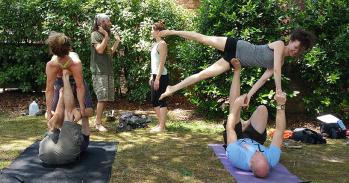A rise in the number of outbreaks of vaccine-preventable diseases has highlighted the growing trend for parents not to have their child vaccinated. Could the activities of a group of teenagers in 1950s America inspire a fresh look at the effectiveness of pro-vaccine public health information campaigns?
A rise in the number of outbreaks of vaccine-preventable diseases has highlighted the growing trend for parents not to have their child vaccinated. Could the activities of a group of teenagers in 1950s America inspire a fresh look at the effectiveness of pro-vaccine public health information campaigns?
Who’d have thought that, after suffering terrible epidemics and fear, Americans would have a very mixed reaction towards polio vaccination? Or that those in the ‘vaccination gap’ would help to fill it.
Stephen Mawdsley
An outbreak of measles in Disneyland sounds like a fairytale gone bad. Yet, in January 2015, states across the USA began reporting measles among individuals who had visited the Disneyland Resort in California the month before. All because a visitor to the resort had unwittingly carried the virus into the ‘Happiest Place On Earth’.
The virus is so contagious that 90% of those close to ‘patient zero’ had been at risk of being infected if they were not already immune. Epidemiologists later concluded that “substandard vaccination compliance” was likely to blame for the outbreak. Six months later, the state of California made vaccination mandatory: from July 2016, all children enrolling in school must be fully vaccinated.
Measles and other vaccine-preventable diseases have been on the rise globally in recent years. France, for instance, seemed close to eliminating measles in 2007, but in the following four years, reported a dramatic outbreak of more than 20,000 cases, with 80% of reported cases occurring in unvaccinated people.
These recent events have highlighted the ‘immunisation gap’ – the trend for parents not to have their child vaccinated because of anxiety about unforeseen health consequences. But without a certain threshold of vaccination in a community – so-called herd immunity – the unvaccinated become especially vulnerable.
Yet, vaccinations are considered to be one of the greatest public health achievements in history. Perhaps that’s part of the problem, says historian Dr Stephen Mawdsley: “We have largely forgotten what it’s like to face an epidemic sweeping through a population.” Vaccinations, it seems, have become a victim of their own success.
But this isn’t the first time that ‘vaccine hesitancy’ has threatened public health. “During the first half of the 20th century, America faced a terrifying disease – polio,” he adds. “As many as 57,000 new cases were being reported every year in the early 1950s. Not only was this a painful illness, it had grave economic consequences. Thousands of survivors required expensive acute and convalescent care, and many suffered from lasting paralysis.”
Although the polio virus could strike anyone, young children were particularly affected, inspiring the term ‘infantile paralysis’. Despite a vaccine being available, few teenagers and adults sought its protection because they believed they were not sufficiently at risk to warrant paying for the course of three inoculations.
Mawdsley’s research, just published in the Journal of Cultural and Social History, has uncovered how young people themselves became the answer to the problem, in what might be the first, largest and most successful case of teen health activism of the time. This fight waged against vaccine noncompliance in 1950s America, he suggests, could provide important lessons for the world today.
It was while hunting through the archives of the March of Dimes (MOD) – a fundraising campaign set up by polio survivor President Franklin D. Roosevelt and his law partner Basil O’Connor – that he made the discovery. “Who’d have thought that, after suffering terrible epidemics and fear, Americans would have a very mixed reaction towards polio vaccination? Or that those in the ‘vaccination gap’ would help to fill it.”
A range of social, economic and political factors complicated the delivery of a comprehensive vaccination programme. Teens, in particular, were a demographic group that was difficult to reach. Two years after the vaccine was licensed in 1955, as many as 30% still had no inoculations, and a third of all new cases were in teens. The public health message wasn’t getting through, and new strategies were needed.
Celebrities helped the cause. ‘Presley Receives a City Polio Shot’ proclaimed the New York Times in 1956, as the King of Rock ‘n’ Roll offered his arm for vaccination before appearing on the Ed Sullivan Show. But the real drivers of the message were a group of teenagers gathered together by the MOD-financed National Foundation for Infantile Paralysis (NFIP).
“Growing consumerism and rising purchasing power and recreational time spurred the emergence of an assertive teen culture by the late 1950s,” explains Mawdsley. “Many national organisations began to recognise teens as important consumers with cultural influence. By tapping into this segment of society, the NFIP hoped to inspire a new wave of vaccination driven by peer approval.”
The relationship was reciprocal. For the hundreds of young people brought together by the NFIP from all over the USA for a conference, this was a chance to challenge negative stereotypes about juvenile delinquency, and gain recognition and appreciation through grassroots activism.
Officials and teenagers debated strategies to improve vaccination, as well as how to break down race, ethnicity and gender stereotypes. The underlying ethos was that the vaccination message could penetrate teen culture only if it came from within its ranks. After the conference, the teenagers established county chapters across the country under the motto ‘Teens Against Polio’ (TAP), each chapter recruiting yet more teens to promote vaccination.
Some canvassed door to door or gave talks at schools; others organised car washes and peanut sales, or visited polio wards and rehabilitation centres. “No shots, no dates” was a recurring phrase, and teens were often asked at school dances to prove they were immunised before gaining entry. “By using exclusive dances as a tactic, young volunteers were able to exploit the fear of missing out as a means to increase vaccine uptake among teens,” he says.
“I interviewed some former TAP volunteers, and they said that looking back it was surprising that some of these tactics were so acceptable – it showed the power of teens understanding and connecting with their own demographic.”
The creativity and audacity of teens were acknowledged as cornerstones to the marketing strategy by adults, as one NFIP chapter chairman recalled: “The youngsters did have enterprise and nerve. They went in offices, stores, restaurants, hotels – any place there was a person. They barged in on bank presidents, dentists, janitors, even the jail.”
Although teen health activists could not solve all the challenges facing vaccination, their strategies had a remarkable effect. As teen vaccination increased, fewer cases of polio emerged. By 1960, the annual incidence of polio had decreased by nearly 90% compared with 1950.
Mawdsley believes that lessons might be learnt from the history of the fight against polio by public health communication campaigns today. “Yes, their approaches and language were very much the product of 1950s America, but the lesson here is that a hard-to-influence group can be reached. This could be by tapping into new forms of communication such as social media, or clever approaches to promoting vaccination to people opposed to vaccination.
“TAP reinvigorated a failing public health campaign by addressing the fears, access restrictions and misinformation about polio. The teen polio crusaders were a Trojan horse in the battle for public support and donations for polio.”
This research was funded by Clare Hall, Cambridge, and Cambridge Infectious Diseases.

The text in this work is licensed under a Creative Commons Attribution 4.0 International License. For image use please see separate credits above.




